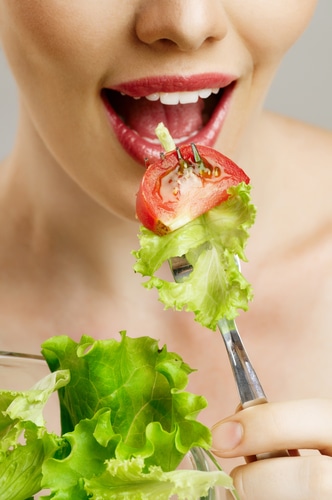
Bite Size Matters
In a study published in the Journal of the American Dietetic Association, researchers gave 54 healthy female college students candy to munch on while they carried out a task on a computer. Half of the group munched on whole pieces of candy while the other half ate candy pieces that had been chopped in half so they were smaller in size. The students were allowed to eat as much candy as they wanted as they completed a 30-minute computer task.
The results? The students in both groups ate the same number of candy pieces, but the group that snacked on the half candy pieces consumed around 60 fewer calories because their pieces of candy were smaller. The girls consistently ate around 10 pieces of candy while completing the task and both groups felt satisfied. The only difference was the size of the candy and the total calories they took in.
This is a small study, but it shows how something as small as reducing the size of the bites you take or the size of the snacks you eat influences eating behavior. Your brain may already have a rough idea of how many bites you need to be satisfied regardless of the size of the bite. Making those bites smaller may work in your favor when it comes to eating less. If you can eat smaller bites and still be satisfied, why not do it?
Other Ways to Trick Yourself Into Eating Less
Cut your food into smaller pieces at the beginning of a meal, and put one small piece on your fork at a time. Another trick is to use chopsticks. It’s hard to take large bites when you’re using chopsticks. Eating with chopsticks slows down the pace of a meal, which gives your appetite hormones a chance to kick in.
Other tricks to help reduce the amount you eat is to train yourself to put your fork down between bites. Serve your food on a small plate in a drab or dull color. Research shows that people eat more when they eat from brightly colored dishes in shades of red, yellow or orange. That’s why fast food signs are often done in shades of red or yellow. Think McDonald’s. Size matters too. You’re more likely to overeat when you eat from a larger plate. Fill your small plate up only once, and don’t leave serving dishes on the table where you have easy access to more food.
The Bottom Line?
Sometimes you have to trick your brain into making more out of less when you’re trying to control your weight. Less food can seem like more if you present it in the right way. Use the power of food psychology to change how you eat and reduce your risk of overindulging.
References:
Diabetes Self-Management. “What’s New in Weight Loss Research”
On Fitness. September/October 2011. page 20.
Related Articles By Cathe:
Portion Size Trumps Mindful Eating for Controlling How Many Calories You Eat
How You Chew Your Food and Its Impact on Nutrition and Weight Control

